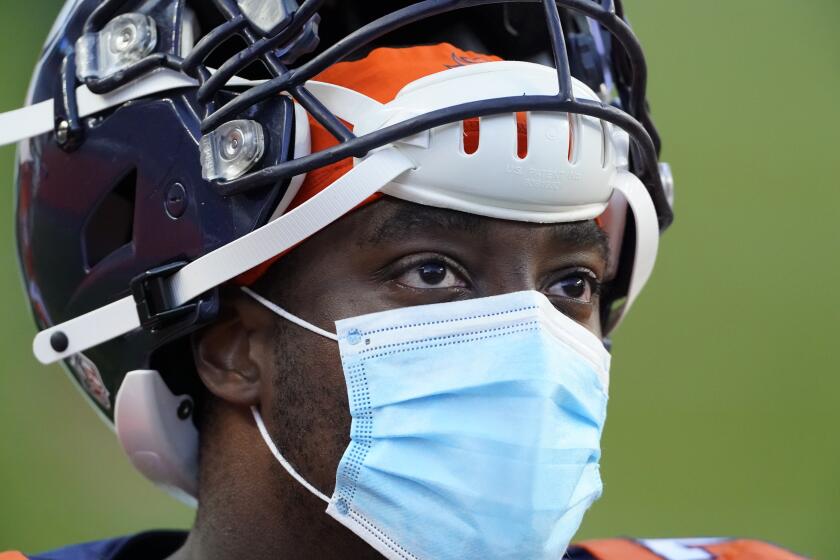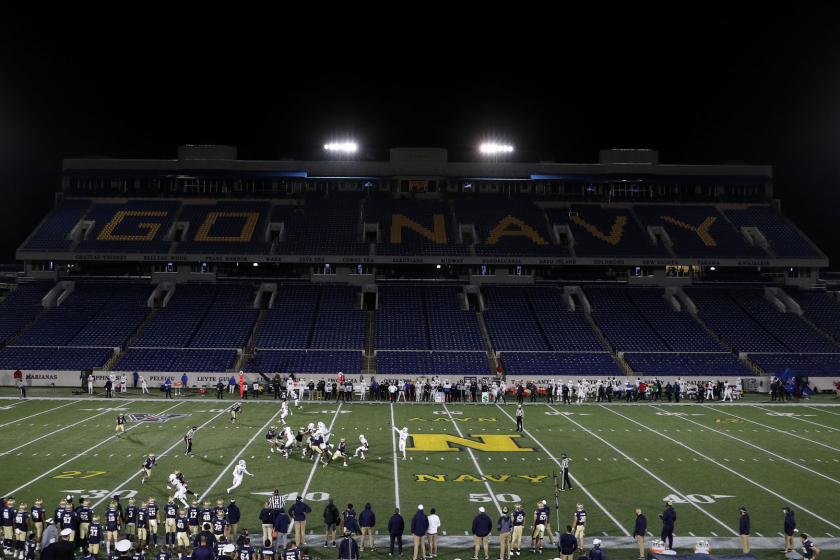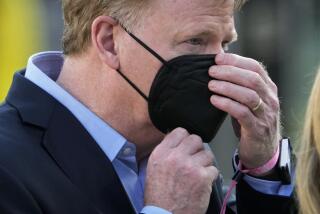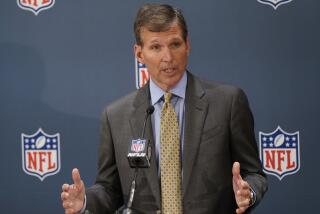Why experts say the NFL’s coronavirus strategy is putting the season in peril
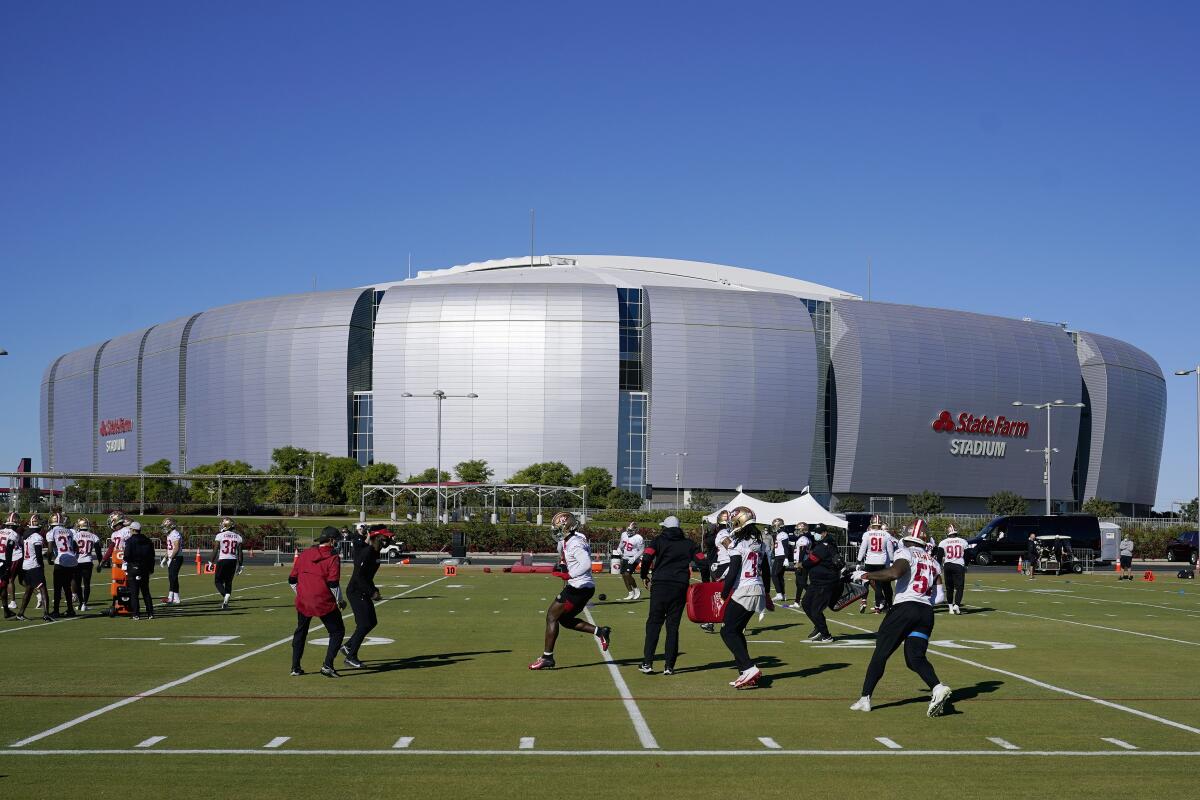
- Share via
As other professional sports leagues planned to tiptoe ahead with quarantined lockdowns, the NFL went boldly and cleverly ahead with a virtual draft so innovative and well received that even strident critics reluctantly applauded it.
The basement of commissioner Roger Goodell’s New York home served as the nerve center for the April event, projecting a sense of calm and confidence as if the world briefly had tilted back onto its axis.
Goodell’s increasingly casual attire over the three days reflected that — from sports coat to sweater to quarter-zip to T-shirt — until he finally plopped into his favorite leather recliner and ate fistfuls of M&Ms. Everything was going to be OK.
The NFL feels very different now. As the country faces a dangerous surge in coronavirus cases, the league is being challenged to duplicate that April success — to keep moving forward, to be innovative and to project that determined assuredness.
“We have said many times this is not going to be easy,” Goodell said. “We all know the virus is in all our communities, and cases are at their highest in months. COVID will continue to pose a major challenge for the NFL as it does for everyone.”
The league is dealing with the fallout from an outbreak that ripped through the Baltimore Ravens, a sham of a game in Denver, where the Broncos played without a quarterback — all four were on the COVID list — and the uprooting of the San Francisco 49ers, who temporarily have relocated to Arizona because of a coronavirus crackdown in Santa Clara County.
The novel coronavirus has turned the NFL and college football seasons into oddities of historic proportions. Epidemiologists aren’t surprised.
Baltimore was supposed to play at Pittsburgh on Thanksgiving night, but the game was rescheduled three times before the teams finally played last Wednesday afternoon. The Ravens had 10 consecutive days of positive tests and at least a dozen players were diagnosed with coronavirus, among them reigning most valuable player Lamar Jackson. Several cases were traced to the team’s strength and conditioning coach, who broke from protocol by not reporting his symptoms and not wearing a mask. He was subsequently suspended by the team.
“Our protocols aren’t failing,” said Dr. Allen Sills, the NFL’s chief medical officer. “Our compliance is an area where we can continue to improve. Any protocol is only as good as the compliance that you have, and as I’ve said before, 90% is a failing grade here. We have to have 100% compliance because the virus only needs a small opening to get in.”
With four weeks remaining in the season, plus the playoffs and Super Bowl, the NFL is like an underwater swimmer trying to get the most out of that last gulp of air and reaching to touch the wall.
“I absolutely think the NFL is going to finish the season,” said Dr. Zach Binney, an epidemiologist at Oxford College of Emory University. “Whether the wheels come off is an open question.”
Three weeks into November, the NFL ramped up its restrictions at all 32 team facilities and entered a period of “intensive protocol,” which mandates that meetings be held virtually, outside or in a practice bubble, with participants safely distanced.
“Nobody wants to be the guy who goes out and does something and then spreads it to a bunch of teammates.”
— Minnesota Vikings guard Dakota Dozier
Banned under the heightened restrictions are in-person contacts among team members outside of the facility, except for travel or games. Cafeterias are grab-and-go only, the use of locker rooms is strongly discouraged, with reduced numbers of people allowed in certain places and increased use of personal protective equipment such as masks and face shields.
“Around our facility, we have a compliance report every week of who’s wearing masks and who’s not,” Rams tackle Andrew Whitworth said. “We actually are tracking how often you’re wearing it, if you’re wearing it properly, and all that. It’s kind of a challenge to us to do it right.”
When teams are in intensive protocol, the NFL has had a 60% reduction in close contacts. Throughout the league, players are responding to positive peer pressure.
“Nobody wants to be the guy who goes out and does something and then spreads it to a bunch of teammates,” Minnesota Vikings guard Dakota Dozier said. “It’s not good for you and your health, obviously, but it’s going to hurt your teammates and hurt your team’s performance. There is that kind of, ‘Hey, I expect you to be responsible, because I’m going to do the same for you.’ ”
Unlike other leagues that created so-called bubbles for their players, existing in hermetically sealed environments, the NFL allows its players to live with their families and therefore incur the risk of more exposure to the virus. The league might create local bubbles for the postseason — with, for instance, the Rams setting up shop in a Los Angeles hotel — but no decisions have been announced. Goodell said all options are on the table.
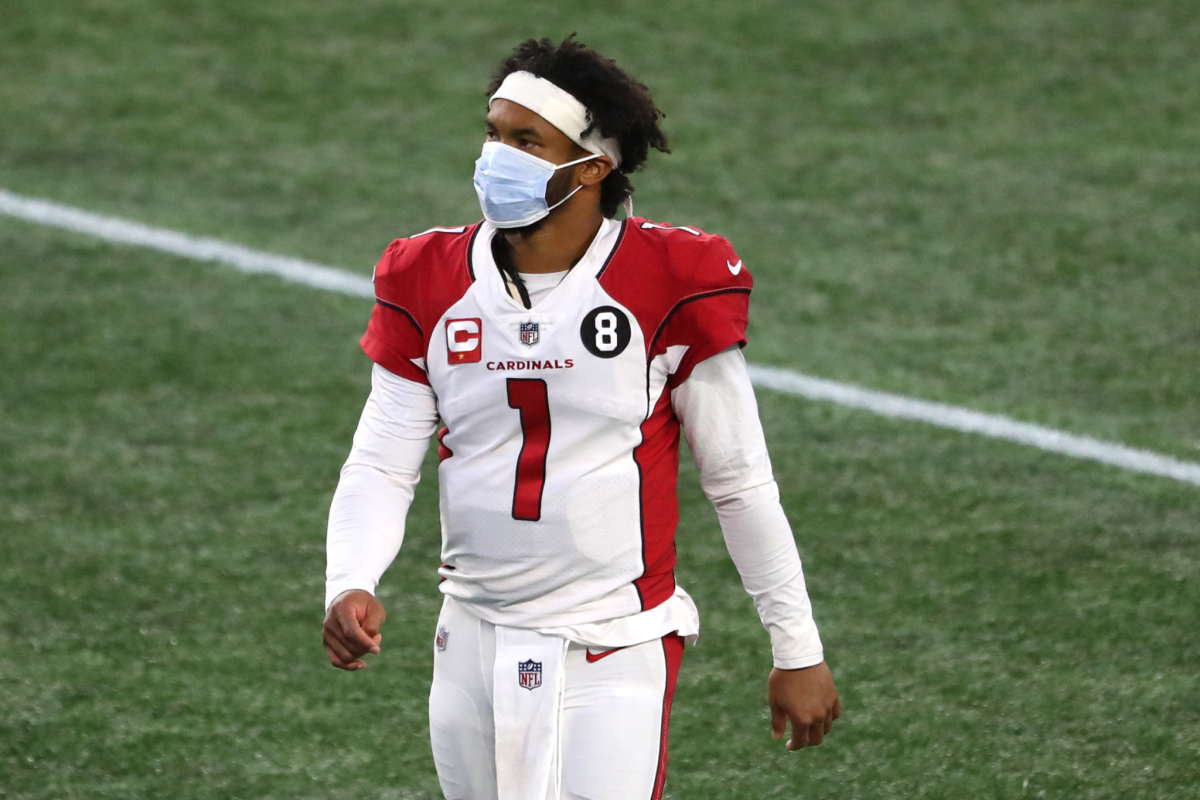
Some infectious disease experts say a bubble is the safest way to go — by far.
“We’re in the most dangerous period in modern public-health history, and I feel it would be smarter to do a real bubble and truly quarantine the way that the NBA and NHL did,” said Dr. Anne Rimoin, professor of epidemiology at the UCLA Fielding School of Public Health.
“I’m not suggesting that they need to shut down, I’m suggesting they need to shut themselves in. If they want to continue to play, recognizing that everybody when you’re not in a sealed bubble will be completely subject to the rate of community transmission that is spiraling out of control.”
Instead, the NFL has relied on daily testing of players and staff; the use of wearable smart tags that monitor the physical distance of interactions between people and for how long they occur; and extensive protocols at team headquarters and in games to mitigate the risk of spreading the virus.
“Right now, their rates are low,” Rimoin said. “Probably what that’s showing is by the rigorous testing they have in place, they are catching people before they’re able to spread the virus to others. But given that it’s a contact sport and that testing is complicated, it’s time to call an audible. It’s time to really consider what could go wrong.”
“At the end of the day, it’s what we say about COVID all the time — testing is imperfect, even under the best of circumstances, and so the risks have to be worth it.”
— Dr. Anne Rimoin, professor of epidemiology at the UCLA Fielding School of Public Health
The NFL says sequestering players for an entire season the way other leagues have would come with a costly psychological toll. Whereas other sports play games multiple times a week, NFL teams play once and cannot safely compress the time frame any further.
“The notion of putting everyone into a bubble is a real challenge, given the number of people and the length of time to play our season,” said Jeff Miller, NFL executive vice president of health, safety and communications. “There are significant challenges, very human challenges, for people to be in those environments.
“So our effort here is, understand that there may be some positive cases, identify those early through daily testing, trace and track those positive cases using the technology available. Identify those people as early as possible and keep the virus from spreading.”
As not to place additional burden on local health care systems, the NFL outsourced its testing to a national vendor, Bio Reference Laboratories, and tests are either driven or flown each day to one of the company’s five labs around the country. Results are available within 24 hours.
Even though the NFL reportedly has paid more than $75 million for testing so far, the notion that players have the luxury of that access to testing is controversial.
“I would rest a lot easier if I felt there were a national push to extend that same thing to everyone,” Binney said.
Nonetheless, testing and contact tracing have led to critical interceptions. The NFL said that in more than 20 cases they have successfully identified a player or staff member who was a “high-risk close contact” on the verge of testing positive, then isolated that person before the virus could spread within the organization.
If the Ravens are on one end of the spectrum, there are plenty of teams on the opposite end. In the second half of November, a dozen teams had no cases among players and there were 16 teams with three player cases or fewer. The NFL said the majority of cases have been asymptomatic or mildly symptomatic.
In the wake of the Thanksgiving holiday, with the Baltimore outbreak in full bloom, the NFL took the unusual step of ordering all headquarters closed for Monday and Tuesday, except for teams that had games scheduled on those days. In a sport in which every minute of practice and meeting time is precious, that was a dramatic decision.
After initially being tenuous about the risks COVID-19, college football power brokers realized revenues could still take precedence over player safety.
According to the latest testing results released by the NFL — for the period between Nov. 22 and 28 — 42,264 tests were administered to 7,819 players and team personnel. There were 33 new confirmed positive tests among players, and 53 among other personnel. That’s a test positivity rate of 0.2%, which Sills said is “well below what we’re seeing in the rest of society.”
He cautioned, however: “We’re certainly not out of the woods. But you can see the effects of the procedures we put in place, and I think the strategic decision to close the club facilities reflects that.”
Rimoin said it’s vital that the NFL not be overconfident in its current low positivity numbers.
“Just because it hasn’t happened yet doesn’t mean it won’t happen,” she said. “At the end of the day, it’s what we say about COVID all the time — testing is imperfect, even under the best of circumstances, and so the risks have to be worth it.
“I’m sure that’s what every player and every person involved is considering.”
More to Read
Go beyond the scoreboard
Get the latest on L.A.'s teams in the daily Sports Report newsletter.
You may occasionally receive promotional content from the Los Angeles Times.

